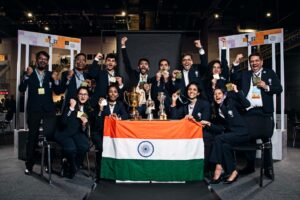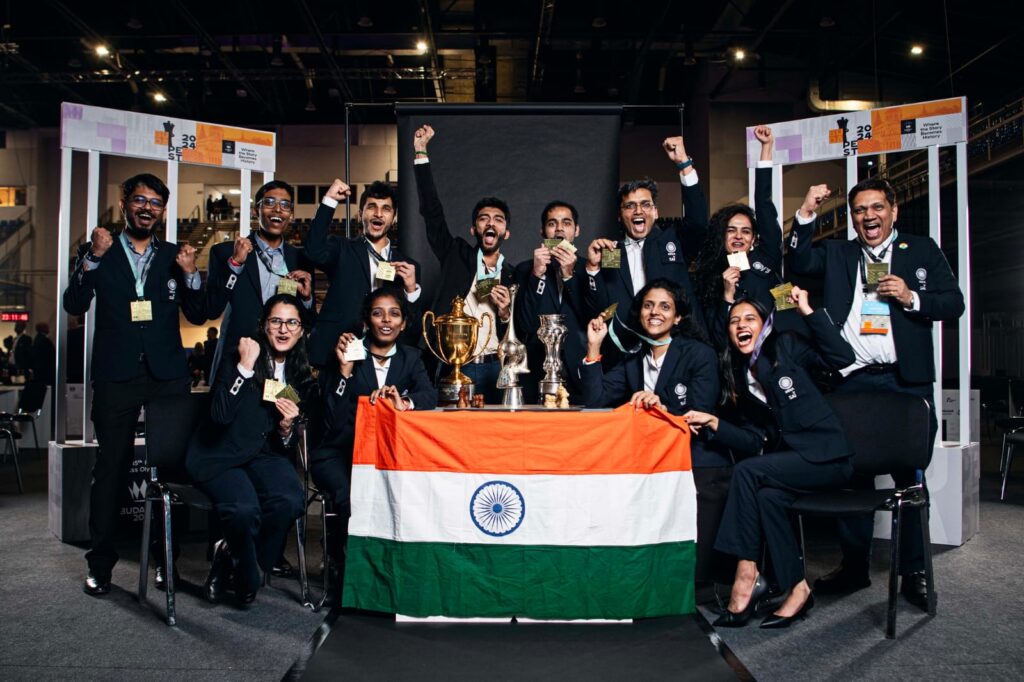
The average age of the Indian quartet that played most of the matches in the open section of the Chess Olympiad is 22. The corresponding number in the women’s section is 24. Gold in both segments of the competition held in Budapest is a testament of the strength of India’s youngsters. Achieving this success with teenagers as regular members of the side is exceptional.
It’s not that Indian youngsters had not been praised for their talent in the past. They had won junior world championships and other accolades. The teams that claimed bronze in the 2022 Chess Olympiad in Chennai featured a number of them. But they had not imposed themselves in a big event like they did in Budapest. Now, they have changed the world order.
D Gukesh, who won eight and drew two games, is 18. Arjun Erigaisi, India’s hitman on Board 3 with nine wins and two draws, is 21. R Praggnanandhaa was slightly average in comparison and scored six points from 10 rounds. He is 19.
Divya Deshmukh was the most outstanding player in the women’s section and registered eight wins and three draws. She is 18. Vantika Agarwal, 22, also played a crucial role with six wins and three draws. R Vaishali was a bit off-colour and scored six points from 10 rounds. She is 23 years old.
This shows that this golden campaign was propelled by the energy, freshness and creativity of youth. They delivered when the chips were down. For a country starved of big-time success after Viswanathan Anand’s last World Championship crown in 2012, this is most encouraging. With age on their side, the current lot can scale any height.
For the Layesy Sports News: Click Here
🚨 Exclusive
The Indian women’s chess team scripted history in Budapest, clinching the Gold medal at #ChessOlympics2024.
The players were overjoyed! Listen to the players as they describe the moment. What does this victory mean for Indian women’s chess?
Listen in 👇… pic.twitter.com/0mLSHBxjxk
— RevSportz Global (@RevSportzGlobal) September 23, 2024
Over the fortnight of the Olympiad, RevSportz spoke to several Grandmasters to know the secret behind this. Or, what makes this possible. All of them, starting from Dibyendu Barua, K Sasikiran and Surya Shekhar Ganguly, said Anand played a massive role in this. He doesn’t coach them directly, but interacts with them, exchanges thoughts and even invites them home to discuss chess.
This has been noticed internationally. Arguably the best player ever, Garry Kasparov, calls this bunch “Anand’s children”. World No. 2 in the September Fide ratings, Hikaru Nakamura of the USA posted on X: “It is truly unfathomable how this kid would come from a country with no chess culture and not only become World Champion, but inspire generations of Indian kids to push chess forward. The legend, @vishy64theking! Huge congratulations to India for winning the @ChessOlympiad”.
There is another factor, as was pointed out by Sasikiran and Ganguly. These boys and girls have received training from some of the biggest names from a young age. Before Covid-19, former world champion Vladimir Kramnik and championship challenger Boris Gelfand had conducted a camp in Chennai. Another former world champion, Rustam Kasimdzhanov, also trained Indian youngsters. Several players who hoisted the Tricolour in Hungary benefited from these programmes.
As Ganguly pointed out, this generation has been exposed to the best of ideas from the formative years. They are aggressive and fearless. “The hunger for success is greater than the fear of failure,” he had said. According to him, the competition has become intense within the country and to be in the Indian team, one has to be a player of high calibre. The bar has been raised.
Proof of that was seen at the Olympiad. The bar has been raised so high that the Indian team waltzed to gold in the open section and the women came back from a short slump to reign supreme. Fittingly, Anand was there near the podium in the playing hall when the trophies and medals were presented. He has passed the baton and it is in good hands.
Also Read: Seeds that Anand sowed finally bear fruit – Indian chess’s time to dominate




